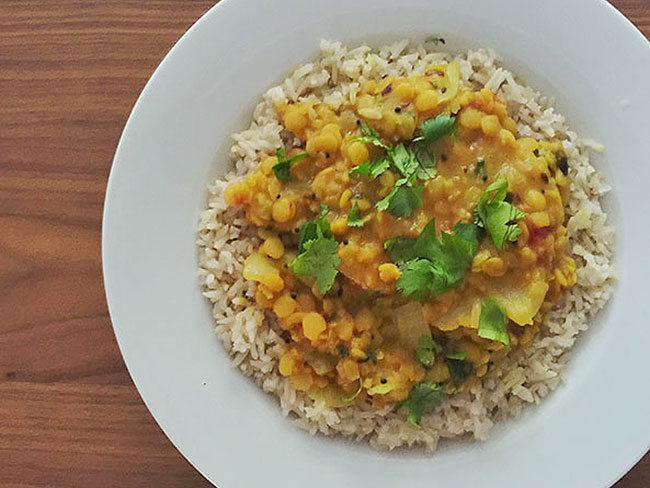Indian yellow dal with coconut rice
This recipe comes straight to you from the heart of India, where this executive chef spent a little time learning the local cuisine. If you've ever wanted to try your hand at Indian cooking, but were afraid to do so, this dish is a great way to hone your skills and get familiar with the typical ingredients and spices that make Indian food so delicious (and healthy!).
Yellow dal, or toor dal is a kind of lentil that is typical in Indian cuisine and can be found in any Indian grocery story. It is not the same as yellow split-peas, although you can substitute one for the other if you can't get access to toor dal (yellow split-peas will cook faster).
When making dal, one of the common steps in the process is to make what is known in Hindi as "chaunk" by which you separately fry the spices and some of the aromatic ingredients in ghee before adding it to the dal. It is the magic that goes into the dal dish, giving it an unmistakable flavor and smell that warms the soul.
Two other ingredients that probably require some explanation for Indian cooking newbies:
Ghee is clarified butter or butter that has been heated to remove the liquid residues. Because of how it is prepared, it tends to have a nuttier and more aromatic flavor to it. It is a staple in India and can be found in any Indian grocery store and many standard grocery stores today in the international aisle.
Asafetida is a powdered aromatic made from gum resin of an herb that is native to parts of the Middle East and India. It has a strong, bitter taste, but enhances the flavors of Indian dishes when added. It is also considered a digestive aid in India.
We think that the best way to enjoy yellow dal is with a side of rice flavored with coconut oil. Interestingly, the Washington Post recently ran a story about how coconut oil, when added to rice, actually reduces the calories of the rice. Isn't that lovely!
Servings: 4 servings
Prep time: 20 minutes
Ingredients
- 1 1/2 cup toor dal, washed
- 1 teaspoon turmeric
- 2 tablespoons ghee
- 1 teaspoon mustard seeds
- 1 pinch asafetida
- 1/2 teaspoon cumin seeds
- 2 sprigs curry leaves
- 1 medium onion, diced
- 4 dried red chilis (add additional chili flakes for added spice)
- 2 medium tomatoes, diced
- 1 cup fresh cilantro leaves
- 1 teaspoon salt (or more to taste)
Coconut rice:
- 2 1/2 cups water
- 1 cup basmati rice, washed
- 1 to 2 tablespoons coconut oil
Directions
- Wash the toor dal and then place in a large pot, add 5 cups of water and turmeric. Cook on medium, uncovered, for about 30 to 45 minutes, or until the dal is soft and blended with the water. Depending on how thoroughly you washed the dal, you may need to occasionally sift off the yellow foam that accumulates on the top of the dal as it cooks. Stir intermittently while cooking and mash with a large spoon as the dal softens. The consistency should be like a thick soup.
- While the dal cooks, chop and prepare your vegetables and gather your other spices together for the chaunk.
- In a medium fry pan, heat the ghee on a low flame.
- Add the mustard seeds and the asafetida and let it fizz for about a minute.
- Add the cumin and curry leaves (adding the curry leaves will make everything sputter, so beware!) and leave cooking again for about a minute more.
- Add the onion and dried chilies and fry until the onion is brown and soft.
- Add the tomato pieces and the cilantro and fry until tender.
- When the chaunk is complete, add this to the dal. If need be, add a little more water to the dal to keep it moist.
- Season with salt and leave the whole thing to simmer for a few minutes, then remove from heat and serve, garnishing with a few cilantro leaves.
- For the rice, bring the water to boil in a small pot, and then add the rice and coconut oil. Cook covered until the rice is soft and the water has been fully absorbed.
Nutrition information (per serving)
- Calories: 450
- Total fat: 13 g
- Saturated fat: 9 g
- Cholesterol: 15 mg
- Sodium: 590 mg
- Total carbohydrate: 69 g
- Dietary fiber: 17 g
- Total sugars: 4 g
- Protein: 17 g
